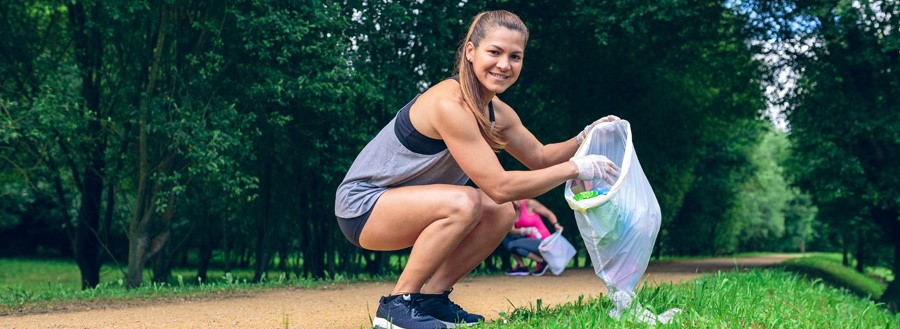Walk, Run or Plog

Campus Recreation wants you to stay healthy and save the earth too!
Please join us during Earth Week (April 16 to April 22) to walk, run or plog. ‘Plogging’
is the Swedish fitness craze designed for those who want to save the earth too. Plogging
is a mash-up of jogging and the Swedish term “plocka upp,” which means "pick up" and
when combined with “jogging”, you get “plogging”. The idea is to pick up trash while
you run or jog.
Not into plogging? You can also try “plalking” which is walking while picking up trash.
What is plogging?
The plogging fitness trend started in Sweden in 2016 and has since spread to other
parts of the world, primarily via social media. Environmentally conscious runners
have taken to collecting trash during their runs. The aerobically taxing and rubbish-collecting
activity was founded by Erik Ahlström, Stockholm-based group Plogga. This group uses
the city’s runners as a force for good for plastic trash collecting. His team of ploggers
pull on their disposable gloves, grab a bag, and scan the streets for recyclable trash
along their running route. Once the bag is full, it’s deposited into a recycling bin.
Let's be like the Swedes and do our part in picking up the trash.
What You Need to Plog
Before you can start plogging there are some essentials and appropriate gear that
you will need.
- A good pair of durable gloves to protect your hands.
- A bag for collecting litter. A plastic grocery bag or another type of small trash
bag will do.
- A good pair of running or walking shoes are a must along with and appropriate clothing
for the activity and the weather.
- A bottle of hand sanitizer is essential for cleaning up after plogging or plalking.
- For those that don't want to touch the trash or bend over, it is essential to have
a “claw” that makes it easier to collect litter without having to strain or touch.
- Be sure to scan the area as you move so that you can optimize your garbage collecting
and stay safe. Plogging can be carried out along rivers, beaches, canals, trails,
in parks, and in the woods.
How to Start Plogging
Plogging is an activity that can be done by yourself or in groups. Generally, plogging
is a social exercise but can be done alone. Plogging in groups helps you stay motivated
and fulfills the need to be social while practicing social distancing. Plogging in
groups also helps you cover more ground. Finding family, friends and neighbors who
like to walk, run or jog can enjoy plogging too.
Safety While Walking, Running or Plogging
Because of crime and traffic, it is imperative to observe certain rules of safety
and etiquette. By taking note of the following safety rules, you will not only be
ensured of a trouble-free workout you will also increase your levels of enjoyment
and pleasure.
- Dress correctly: Plogging in the dark is not recommended, however, if you must be out when it is still
dark, ensure that you are dressed to be seen. Drivers at night or early mornings are
rarely on the lookout for walkers and runners, so you need to wear light-colored or
reflective clothing like shocking-pink or brilliant orange. Many brands of running
and walking shoes have reflective material on the heels, and outdoor gear can be purchased
with reflective strips. Reflective belts are also an option. Stay away from dark clothing
colors such as blue, black or navy as this makes you virtually invisible. If you don't
have reflective gear or light colored clothing, wear anything white.
- Walk, run or plog with another person: If at all possible, recruit a partner. Not only does this increase your safety but
it also makes your training so much more enjoyable. If you do venture out on your
own, always tell someone the route you will be on, what time you expect to return
and share your location on your smart phone for the duration of the workout.
- Walk defensively: Never assume that all road-users know about the 'pedestrian has right-of-way' rule.
Many of them don't.
- Lose the jewelry: Leave your valuables at home.
- Vary your routes: Don't establish regular patterns by walking the same route at the same time every
day by randomly varying your routes and the times that you go out. Not only is it
safer, but it's a lot more interesting.
- Carry ID: Always carry some form of identification in case of an accident or medical emergency.
- Keep right: If you're walking on a cycling or pedestrian path, always walk or run on the right
hand side so that faster walkers, runners and cyclists can easily pass you on your
left. If you're out with others, don't hog or cross over the path without looking.
- Leave the earbuds at home: That way you will be alert to any potential dangers, be it a dog, a fast-approaching
car or cyclist, or the sound of other people around you.
